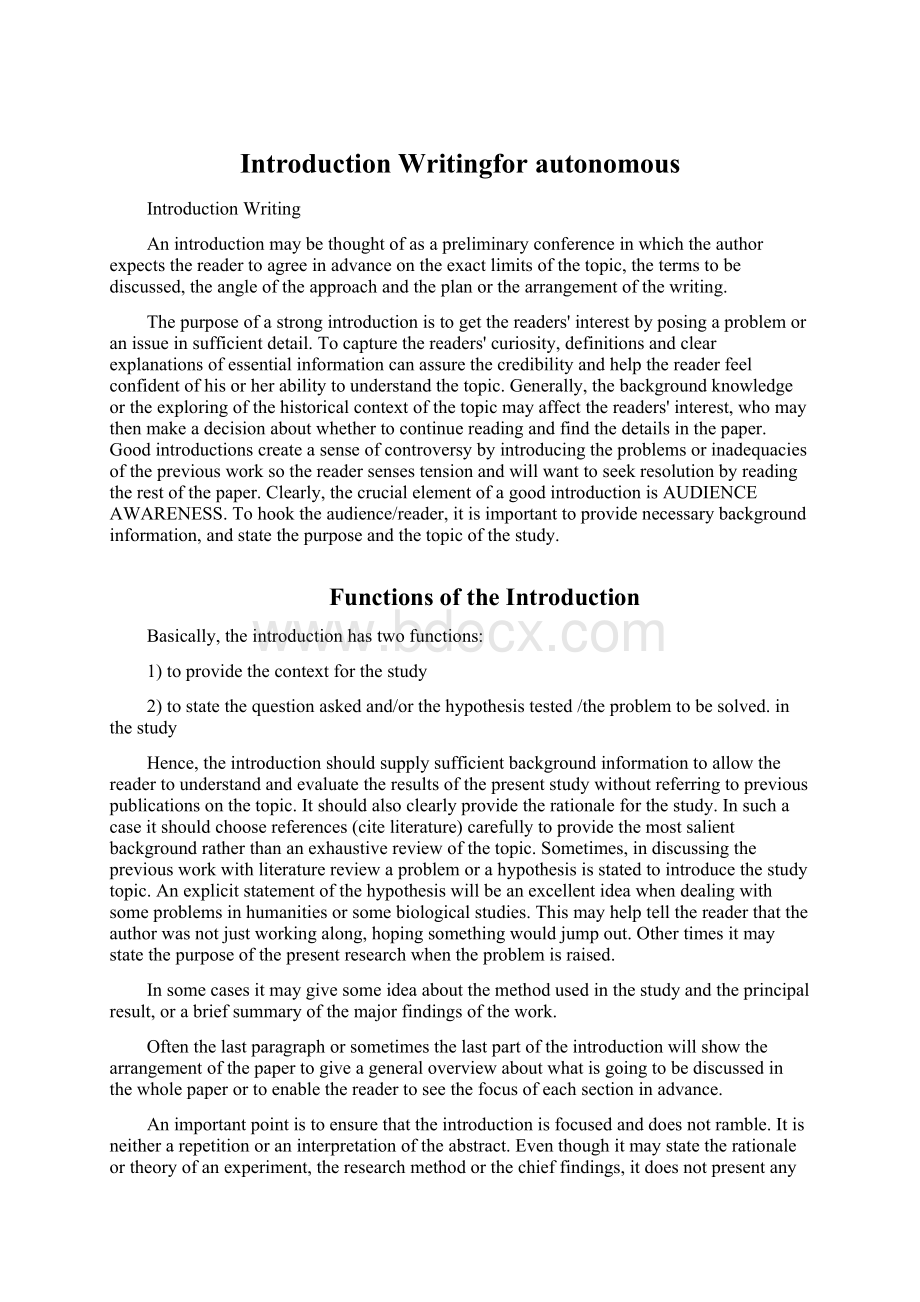Introduction Writingfor autonomous.docx
《Introduction Writingfor autonomous.docx》由会员分享,可在线阅读,更多相关《Introduction Writingfor autonomous.docx(19页珍藏版)》请在冰豆网上搜索。

IntroductionWritingforautonomous
IntroductionWriting
Anintroductionmaybethoughtofasapreliminaryconferenceinwhichtheauthorexpectsthereadertoagreeinadvanceontheexactlimitsofthetopic,thetermstobediscussed,theangleoftheapproachandtheplanorthearrangementofthewriting.
Thepurposeofastrongintroductionistogetthereaders'interestbyposingaproblemoranissueinsufficientdetail.Tocapturethereaders'curiosity,definitionsandclearexplanationsofessentialinformationcanassurethecredibilityandhelpthereaderfeelconfidentofhisorherabilitytounderstandthetopic.Generally,thebackgroundknowledgeortheexploringofthehistoricalcontextofthetopicmayaffectthereaders'interest,whomaythenmakeadecisionaboutwhethertocontinuereadingandfindthedetailsinthepaper.Goodintroductionscreateasenseofcontroversybyintroducingtheproblemsorinadequaciesofthepreviousworksothereadersensestensionandwillwanttoseekresolutionbyreadingtherestofthepaper.Clearly,thecrucialelementofagoodintroductionisAUDIENCEAWARENESS.Tohooktheaudience/reader,itisimportanttoprovidenecessarybackgroundinformation,andstatethepurposeandthetopicofthestudy.
FunctionsoftheIntroduction
Basically,theintroductionhastwofunctions:
1)toprovidethecontextforthestudy
2)tostatethequestionaskedand/orthehypothesistested/theproblemtobesolved.inthestudy
Hence,theintroductionshouldsupplysufficientbackgroundinformationtoallowthereadertounderstandandevaluatetheresultsofthepresentstudywithoutreferringtopreviouspublicationsonthetopic.Itshouldalsoclearlyprovidetherationaleforthestudy.Insuchacaseitshouldchoosereferences(citeliterature)carefullytoprovidethemostsalientbackgroundratherthananexhaustivereviewofthetopic.Sometimes,indiscussingthepreviousworkwithliteraturereviewaproblemorahypothesisisstatedtointroducethestudytopic.Anexplicitstatementofthehypothesiswillbeanexcellentideawhendealingwithsomeproblemsinhumanitiesorsomebiologicalstudies.Thismayhelptellthereaderthattheauthorwasnotjustworkingalong,hopingsomethingwouldjumpout.Othertimesitmaystatethepurposeofthepresentresearchwhentheproblemisraised.
Insomecasesitmaygivesomeideaaboutthemethodusedinthestudyandtheprincipalresult,orabriefsummaryofthemajorfindingsofthework.
Oftenthelastparagraphorsometimesthelastpartoftheintroductionwillshowthearrangementofthepapertogiveageneraloverviewaboutwhatisgoingtobediscussedinthewholepaperortoenablethereadertoseethefocusofeachsectioninadvance.
Animportantpointistoensurethattheintroductionisfocusedanddoesnotramble.Itisneitherarepetitionoraninterpretationoftheabstract.Eventhoughitmaystatetherationaleortheoryofanexperiment,theresearchmethodorthechieffindings,itdoesnotpresentanydetaileddescriptionsoranysuggestionsandconclusions.Atthesametime,theauthorshouldnotbemodestabouthisorherresearchcapabilitiesoranyevaluationofthepaper.Evenifso,theendoftheconclusionpartmaybeagoodplace.
Therefore,aneffectiveintroductionusuallycontainsthefollowingelements
1)thegeneralbackgroundknowledge,suchasthedefinitionofaterm/terminology,thepreviousstudies(findingsandproblems)and/orareviewofhistoricaldevelopmentofthestudy;
2)thepurposeofthepresentstudy;
3)theproblemtobesolved/thehypothesistobetested;
4)ageneralviewofthepresentstudy(suchasthefunctionorstructure,themethodandthemajorfindings)
5)thearrangementororganizationofthepaper.
CharacteristicsoftheIntroduction
Toaccomplishthepurposeofestablishingthecontextforthestudy,atypicalintroductionusuallyhasthefollowingfeatures:
◆identifiesthegeneralareainwhichthestudytakesplace;
◆givesaconciseandappropriatebackgrounddiscussionoftheproblembyoutliningthemostpertinentpreviousscientificworkrelatedtotheissueunderstudy;
◆showshowthepreviousworkrelatestotheproject,demonstratingthecontinuityoftheprojectwiththatworkbutalsopointingoutthedifficultiesorinadequaciesinthepreviousworkthatprovidesthefocusfortheproject(thisistheresearchproblem);
◆statesthehypothesisand/orresearchquestion;
◆presentsaverybriefoverviewofthepaperorexperimentalprocedure.
Henceaneffectiveintroductionshould:
∙presentabroadconceptualframework,rationaleandpurposeofstudy,includinghypothesisandpredictions
∙hookthereader
∙proceedfromgeneraltospecific-reviewcurrentknowledgeontopic(requiresliteraturecitations)andnarrowdowntothespecifictopic
∙citekeyreferencesinthefield,fromgeneraltospecific
∙giveanoverviewofthewholepaper.
Normally,theintroductionwillbeorganizedinthefollowingway.
1.startingwiththeresearchbackground;
2.transitingtotheexistingproblem;
3.focusingonthepresentresearch;
4.presentinganoverviewofthewholepaper.
Waystostartanintroduction
1.statingthetopicdirectly
2.raisingaquestionoraseriesofquestions
3.quotingfromotherresearchersorpreviouswork
4.definingaspecificterm
5.presentingthestatistics
6.givingahypothesis
Oryoumayask:
1.Whatisthebackgroundorgeneralareaofthestudy?
2.Whatisthepurposeofthispaper?
3.Whatisthepreviousworkabout?
OrWhatarethedifficultiesorinadequaciesinthepreviouswork?
4.Whatisthespecificproblem/subjectorlimitthepaperwilldiscuss?
5.Whatisthearrangementofthepaper?
Orsimply:
Whatbackground?
Whatpurpose?
Whatpreviouswork?
Whattopic?
Whatarrangement?
However,theintroductionofapaperwillbealittledifferentfromthatofathesisordissertationwhichmayshowthecontentofeachchapterinthelastpart.
WhilethefirstchapterofadissertationisnormallygiventhetitleIntroduction,anditservesmanypurposes.Itistheplacewhereyoushould
∙discussthemotivationfortheworkthatisbeingreported
∙stateanddefinetheproblemthatthedissertationistryingtoaddressorsolve
∙statetheaimsandobjectivesofthework
∙giveanindicationofhowtheworkwillbeprogressed
∙provideabriefoverviewofeachofthemainchaptersthatthereaderwillencounter
componentofadissertationintroduction
✓Subject(generaldescription)
Identifyspecifictopic,andthendefine,limitandnarrowittooneissue
✓Background
Providerelevanthistoricaldata.Discussafewkeysourcesthattouchonthespecificissue
✓Problem(theneedforthestudy)
Identifyandexplaintheproblem,complicationsandtheissue
✓Thesisstatement
Toestablishthedirectionofthestudyandtopointreaderstoyoureventualconclusion
6.1.2waystobeginanintroduction
✓startingwithanAnecdote
Letmebeginwithaspecialevent.Itoccurredin….hebegantotranslatelateindeceber1827…
✓providebackgroundinformationtobeacontextfortheissue
Thereforewecansay
“TheIntroductionshould"introduce"thepaper.Thereadershouldbepresentedwithenoughbackgroundinformationtobeabletounderstandandevaluatethepurposeofyourstudywithouthavingtorefertootherworks.Therationaleforthestudyshouldbepresented.Providesalientreferencesbutavoidtryingtomakeanexhaustivereviewofthetopic.
Intheintroduction,definetheproblemclearly.Iftheproblemisnotstatedinareasonable,understandableway,thereaderwillhavenointerestinyoursolution.Followwithsomereviewoftheliteraturetoallowthereadertounderstandwhythestudyisnecessaryandhowyouattemptedtoresolveit.Talkingeneraltermsabouttechniquesusedtosolvetheproblem,ifnecessary,butdonotpresentanyspecificsabouttheprotocolshere.Thefinalportionshouldbethestatementoftheprincipalresults.
∙Presentthenatureandthescopeoftheprobleminvestigated.
∙Provideenoughbackgroundtoorientthereaderandjustifythestudy.
∙Statethegoal/objectivesandmethodoftheinvestigation.
∙Brieflystatetheprincipalresultsoftheinvestigation.”
(http:
//www.owlnet.rice.edu/~bios311/bios311/sciarticle.html)
Swales'’ModeofIntroductionWriting
Macromodel:
Overallorganizationoftheresearchpaper(Hilletal.,1982)
IntroductionGeneral
Particular
Procedure
DiscussionParticular
General
MicromodelofResearchArticle’sIntroduction:
CARSModel:
CreateaResearchSpacemodel(Swales,1990)
Move1Establishingaterritory
Step1Claimingcentrality
And/or
Step2Makingtopicgeneralization(s)
And/or
Step3Reviewingitemsofpreviousresearch
Move2establishinganiche
Step1ACounter-claiming
or
Step1BIndicatingagap
or
Step1CQuestion-raising
or
Step1DContinuingatradition
Move3Occupyingtheniche
Step1AOutliningpurpose
or
Step1BAnnouncingpresentresearch
Step2Announcingprincipalfindings
Step3indicatingRAstructure
Thiscanbeexplainedinthefollowingtable:
Move1
Establishingaterritory
Step1Claimingcentrality
and/or
Step2Makingtopicgeneralizations
and/or
Step3Reviewingitemsofpreviousresearch
Move2
Establishinganiche
Indicatingagap
Move3
Occupyingtheniche
Outliningpurposeofpaper(arrangement)
ThefollowingshowshowonecancombineSwale'sandHoey'sapproaches.
Situation
Establishingaterritory
○
Claimingcentrality
○
Makingtopicgeneralizations
○
Reviewingitemsofpreviousresearch
Problem
Indicatingagap
Solution
Occupyingtheniche
○
Outliningpurpo